A
fascinating
animal found in Niagara County
Outdoors in Niagara
Mark Daul
 Did
you ever hear of an animal that can pay
for its own yearly maintenance, like
veterinarians fees, room and board, and
be a great pet at the same time? In
Niagara County, the
Lewiston-Porter-Newfane areas
especially, there are some people
harboring critters that can do those
things, while at the same time making a
hobby of raising and caring for these
docile animals. Of course, there are
many of these critters in other counties
across the state and the country, but
Niagara County has its own distinction.
These animals stand between 32 and 39
inches tall at the shoulders, weigh
between 105 and 185 pounds, have
straight legs when looked at from the
front or the back, and each foot has
only two toes. Their back legs have a
45-degree bend like those of other
four-legged creatures when looked at
from the side.
Looking closer, you see that their ears
are spear-shaped, like those relic
Indian spears we have all seen pictures
of. These animals are related to the
camel family, but they normally don't
spit at humans like their bigger
relatives do. They are known as alpacas,
an animal that the Chavin culture in the
Andes (Peru) in South America some 6,000
years ago harbored for meat, work, and
fleece. Later, the Incas were credited
with domesticating these pack animals,
and they were raised for their fleece,
which was woven into fine clothing,
particularly reserved for royalty at the
time.
It is estimated there are about 3
million Alpacas worldwide and only about
17,000 of them in the U.S. Alpacas are
not used for meat production like they
were centuries ago. Today they are used
for the production of a highly
sought-after fleece, which is higher
quality, much softer than sheep's wool,
lighter, stronger, hypoallergenic, and
having no prickly feel like wool. They
were introduced in this country in 1983.
Robert and Dee Oberlander have a horse
farm on Braley Road in the Town of
Porter, boarding horses for local
owners. They had an extra barn that was
underused and decided to get two alpacas
for a hobby. In six short years the
family has grown to 14.
Robert (Obie) and Dee harvest their own
fleece from a herd of alpacas they
harbor on their farm and keep all 14 of
them. Obie says, "You never know, we
keep adding to our family now and
again." He added, "Holy smokes, we just
adopted a Suri the other day."
There are two breeds of alpacas, and the
Oberlanders favor the Huacaya,
(pronounced "wa-ki-ya") because it is
easier to treat and prepare the fleece
for weaving. The other is called the
Suri (pronounced "surrey"). The fleece
of the Suri is stringy with longer curly
fibers that make it harder to work with,
although it feels softer and fluffier
when woven.
From raising, to feeding, caring for,
shearing, washing, dying, carding,
weaving, and knitting; to creating hats,
gloves, sweaters, scarves, capes and
socks for their family and friends, the
Oberlanders do it all themselves. Their
herd is sheared every spring, and each
animal gives up about five to seven
pounds of fiber.
On a visit, I saw scarves, sweaters,
capes, purses and hats, all handmade
from alpaca fleece by Dee from scratch.
Obie says they shear in the spring; this
way the summer heat isn't so hard on
their "family." The Oberlanders note
there are about 20 to 22 different
shades of color that alpacas have, and
white can be dyed any color. White and
black are the favorites among many. Dee
uses a food coloring process and warns
not to use clothing dyes like Ritz. She
also warns not to use aluminum pots for
the dye, only enamel or stainless steel.
The food dyes work perfectly like they
do on Easter eggs, because they both
have a lot of protein.
Carding is a process where the raw
fleece of the alpaca is broken up into
clumps of fiber, and then aligned to
individual fibers that prepare the fiber
for easier weaving into strands called a
"cloud." After the cloud is hand-rolled
into strands, it is then separated as it
is being run through the spinning
process. Dee started out with hand
carding, but quickly turned to drum
carding. Seen in the photo, the drum
carder machine is hand-cranked and makes
the process much easier, putting strands
into a treadle-powered spinning wheel.
Dee took lessons to learn this process.
Her teacher showed how it was done back
in ancient times, by making yarn by hand
spinning. It's an art still used today
in some countries and with hobbyists.
She started out with a small spinning
wheel, then graduated to a better one,
then another, and finally settled on the
one she is using today. Her household
contains four of these wheels and all
are still operable. It goes to show how
hobbies can become an obsession. Her
hobby occupies two rooms, one downstairs
for the carding process, cleaning,
drying, and storage. The upstairs room
is the spinning room, where everything
finally comes together.
One day while driving by I stopped and
visited with the alpacas. They were
friendly and unusually nosey. One after
the other came over to see me. One hung
around staring me in the face, and made
a low, clucking, friendly type of a
sound. I had a conversation with him,
and he seemed to know what I was saying
over the fence. I asked if he would
smile at the camera, and the picture you
see is what I got. What an elegant pose.
One interesting thing I learned on my
visit is that alpacas are very tidy;
they use a communal dung pile somewhere
in a corner of their corral where they
do not graze. Females have a tendency to
"follow the leader." When one goes, the
rest of the females line up at the same
time, and go in the same place one at a
time.
A few days later, I again visited the
Oberlander's at their farm, and asked
about that "friendly guy" that greeted
me at the fence. Obie said, "Oh, you
must be talking about the 'Old Man!' "
He explained the "Old Man" was his very
first alpaca of the pack and is a really
friendly character. "He likes
everybody," I was told.
Alpacas of Niagara, located on Tonawanda
Creek Road in Lockport, is a large
Western New York breeding farm, offering
all kinds of services to other owners
and breeders. Recently they held the
area's first "Alpaca Fiber and Harvest
Festival" at the former Amherst Museum,
featuring an Alpaca fashion show, a
first in Western New York. Among the
many assorted vendors, there were live
alpacas and dozens of vendors with
handmade and selected imported alpaca
products.
The farm includes an Alpaca Shop where
you can purchase alpaca knitted goods
with an emphasis on locally produced,
hand-made, and made-in-the-USA items.
Visit their website for more information
and location:
www.alpacaniagara.com .
Those with elementary-aged children
might want to think about taking a trip
to visit these friendly alpacas. The
Oberlanders welcome children and would
show them all about these ancient beasts
of burden. The alpaca is a clean and
fascinating creature, and children could
even take them for a walk without being
spit upon. Phone Dee at 716-745-3173 for
arrangements in the spring; maybe you
can even watch the shearing and learn
how that is done.
Yes, the great outdoors is where it's
at. Enjoy it frequently.
|
|
Outdoors in Niagara
Mark Daul
Bond Lake
– A Hop, Skip, and a Jump Away – Bring Paper
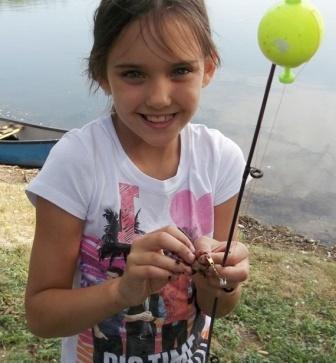 Niagara
County’s Bond Lake Park, is a 531 acre park facility, located off Lower
Mountain Road outside of Lewiston. The lake area itself was once a
limestone quarry site back in the late 1800’s spanning into the very
early 1900’s before it closed. Today it is a nature-themed park and is
open to the public. Fishing, hiking, canoeing, picnicking, skiing,
sledding and so much more, and not more than 20 minutes away from any
resident of Niagara County. One thing, in the Lake area especially,
there are NO restrooms, a real shame for a public park as nice as this.
If you picnic at one of the two beautiful picnic pavilions, be prepared
to solve your own problems with your family. I would think the Niagara
County lawmakers could come up with a couple of bucks for a couple of
facilities, that can be bought or rented pretty reasonably. I took a
short 25 foot walk up one trail and was met with stale toilet paper on
each side of me; nice for kids & ladies huh? In the meantime, bring a
roll and go where the bears go, in the woods, after all, maybe that’s
what “nature-themed” means. [No, there aren’t any bears.] Niagara
County’s Bond Lake Park, is a 531 acre park facility, located off Lower
Mountain Road outside of Lewiston. The lake area itself was once a
limestone quarry site back in the late 1800’s spanning into the very
early 1900’s before it closed. Today it is a nature-themed park and is
open to the public. Fishing, hiking, canoeing, picnicking, skiing,
sledding and so much more, and not more than 20 minutes away from any
resident of Niagara County. One thing, in the Lake area especially,
there are NO restrooms, a real shame for a public park as nice as this.
If you picnic at one of the two beautiful picnic pavilions, be prepared
to solve your own problems with your family. I would think the Niagara
County lawmakers could come up with a couple of bucks for a couple of
facilities, that can be bought or rented pretty reasonably. I took a
short 25 foot walk up one trail and was met with stale toilet paper on
each side of me; nice for kids & ladies huh? In the meantime, bring a
roll and go where the bears go, in the woods, after all, maybe that’s
what “nature-themed” means. [No, there aren’t any bears.]
The picture of the girl wearing the great big smile
is because she is out fishing with her parents. Not fishing for exotics,
just ‘out’ fishing! Not fishing in a big lake, not fishing from a boat,
but fishing off shore at Bond Lake.
The little fishergirl in the picture, is Brandi
Love Fischer, a 9 ½ year old [going on 25 yrs. her Mom says] that I met
at Bond Lake fishing with her parents. When I asked her name she
promptly told me ‘Brandi,’ then I asked “how old are you Brandi?”
gleefully, she said ‘10’while she was baiting her own hook for another
cast. Her proud stepdad, Russ, told me she does everything by herself,
and sure loves fishing. In about 5 minutes her mother caught a fish and
Brandi took it off the hook for her, and then before she released it,
she held it up like she was going to give it a big fat kiss. The fish
wiggled unexpectedly, while she was holding it, and Brandi let out a
little scream like 10 year olds do, it was an unexpected surprise. After
her cute theatrics, she leaned over and put it back in the water for
another day. Just from that, you can see Mom and Dad are good teachers.
Its things like this little story that makes my day.
I often get asked by people where there is a good
safe place to take kids fishing, where they’ll catch fish, be safe, and
learn to fish without a boat. Those are good questions for sure,
especially the last one. I can tell you, we have lots of places around
here to do that. Quite often I’m asked about the real young ones, from 3
to 7 years old. Although any age is a good age, I say if they can stand
up on their own, start then. Sometimes attention spans are narrow, so
when you are out, take them around and explore other things. Frogs,
birds, salamanders, butterflies, trees, are all things that they will
remember for the next trip. I realize all parents are not necessarily up
on fishing, and the other things the great outdoors has to offer, but
what better way to learn than when teaching your children, and you’re
learning things for yourself at the same time. I find a lot of parents,
including single parents, would rather have their kids in organized
sports where the teaching and coaching is done by someone else,
sometimes even by strangers. Team sports are wonderful, but nothing
compares to getting out on your own, learning on your own, and as you
grow up, there is just you and a fish, and the outdoors. Fisher people
when fishing are strictly one on one, just “the fisher and the fish.”
The fisher tries to figure out how those fish think, while the fish is
looking for a simple meal, and at the same time outsmarting the fisher.
Like scoring a touchdown or a home run in little league, the fisher gets
a thrill, but all kids can’t score touchdowns or home runs, so guess
what, all kids can catch a fish!
Starting out, remember you won’t get much fishing
in yourself, not until the youngster gets comfortable with baiting their
own hook, and taking their own fish off the hook. Some take longer than
others, but if you show the proper way to do it right from the start,
they will want to learn like you did, or you can learn together. Maybe
you are not a very good fisherperson yourself, so what, bring a couple
of old rags with you, something like an old terrycloth washcloth or an
old bath towel torn into pieces for your hands. They will help you keep
your fish under control until you unhook it, and get it back in the
water. Getting the fish back in the water is the first lesson in “Catch
& Release.” Releasing fish unharmed back into the water is a good
lesson, because it is protecting what we have for the future
fishermen/gals.
So your trip starts out on the right foot, be sure
to bring sun lotion, insect repellant, a snack of some kind and a
liquid. You might even want a Band-Aid or two, just in case. The experts
say between 11:00 am and 2:00 pm in the afternoon are the hottest times
of a day, so avoid those times. It’s always best to go early.
Take a trip to your neighborhood tackle store and
pick up a 4 or 5 foot spincast rod & reel for your child for starters.
Cost is 10-15 dollars for child size starter set for 3-5 year olds. You
don’t want anything too long or you will be untangling line cast after
cast. and pulling line out of trees. A 6 ½ or 7 foot hand-me-down rod is
fine, if you have an older learner, but make sure it works good. Kids
are fast learners so you don’t want defective tackle, then their
interest is driven away. Of course, you can buy bait, worms in most
cases, in many of these shops and other places along the road. But the
very best thing to do, is go out with the child the night before, go
digging for worms yourselves, or spray your lawn an hour or so before
dusk, and pick them off the grass after dark. They are free then. Or
you can even try a small ball of fresh bread on your hook.
When kids start out, they don’t want big fish to
scare them, they just want the thrill, a little sunfish or rock bass
will do fine. It’s like hitting that home run I talked about. This is a
good time to teach them about their surroundings, and taking care of
those surroundings. Make sure they don’t leave bait containers, sandwich
wrappers and other junk lying around. Have the kids pick up any
containers, or debris that might be left behind, not you, they won’t
learn a thing if you do it for them, remember someday they’ll be fishing
without you. If there is junk around other people left, make that part
of the cleanup too, the kids don’t mind, they will feel even more
important, and will learn a good lesson.
After all this about taking kids fishing, don’t
forget the elders, they would just love to tag along on a simple little
fishing trip too!
|
|
Outdoors in Niagara
Mark Daul
Note: Picture is of author
Fishing With
Don Supon
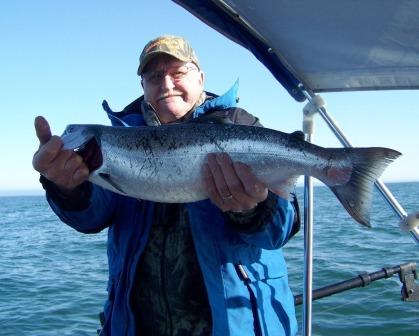 Who
is Don Supon? That’s your first question I’ll bet. Let me tell you, and
bring you up to date. He lives in Niagara Falls with his wife Myra. Don
is a retired school teacher, and outdoors enthusiast from the git-go.
Don owns a deer camp in the Southern Tier that he maintains and visits
often. It has trail cams set up so when he is not at the camp, he can
watch what wildlife activities appear before the cameras in his absence.
He has shown me cam pictures of turkey, bear, coyote, and of course,
deer. Hunting has always been one of Don’s major pastimes and I’m glad,
because now I have some venison in my freezer. Who
is Don Supon? That’s your first question I’ll bet. Let me tell you, and
bring you up to date. He lives in Niagara Falls with his wife Myra. Don
is a retired school teacher, and outdoors enthusiast from the git-go.
Don owns a deer camp in the Southern Tier that he maintains and visits
often. It has trail cams set up so when he is not at the camp, he can
watch what wildlife activities appear before the cameras in his absence.
He has shown me cam pictures of turkey, bear, coyote, and of course,
deer. Hunting has always been one of Don’s major pastimes and I’m glad,
because now I have some venison in my freezer.
We met several years ago, when we were both younger
and doing our separate things, never really getting into deep
discussions. Having the same acquaintances, and the same interests, our
relationship increased as we bumped into one another on occasion, and
volunteering for the betterment of outdoor activities. Now, neither of
us do much volunteering, at our age, but still help out wherever we can.
Both of us always remind people to get out and enjoy the outdoors. As
the saying goes, and its origin is uncertain; “Yesterday is history.
Tomorrow is a mystery. Today is a gift. That's why it is called the
present.”
Don and I took up fishing together a couple of
years ago, and we enjoy each others company, mostly. By mostly, I mean
when we get out fishing together, I am mostly out fished by him. We are
both nuts for perch fishing and that is what we ‘mostly’ do. A couple of
years ago, Don was looking for someone to fish the spring trout and
salmon derby with and I volunteered. When I said I’d fish it, the
weather was pretty nice, so I paid my entry fee and signed up for the
event. The day we went out, the weather changed. We got out in the lake
and set up around the green can [buoy] off the mouth of the Lower
Niagara. I froze on our way out and froze when we settled down after
putting our rigs out, then froze on the way back to shore. The wind was
blowing from the northwest, with a wet drizzle, until the sun broke.
Even then it was still cold, the wind has no mercy. We trolled for hours
and all the while I’m thinking to myself, this is the reason why I gave
up on this type of fishing many years ago. From then on, I will always
remain the ‘sunshine man,’ the type that only goes fishing when the sun
is shining and the thermometer reads over 65 degrees. Don owns a
salmon/lake boat equipped with all the bells and whistles, a roof with
side curtains, and now his lake fishing is all done with a new fisherman
learning the ropes, Dave Anastasia, a Ransomville resident. I said
learning, but I know Dave catches on fast, especially from a good
teacher.
The fish you see me holding in the picture isn’t
mine, I’m just holding it for Don, like all good guests should do for
the host. I’m dressed in layers with a good quality wind and rain
resistant Sterns jacket on with a hood, and if this was in color, you
could see my hands are beet red.
A few days ago, it wasn’t over 65 degrees, and the
sun wasn’t shining even though Don Paul on Channel 4 said it was going
to be, we took our chances and went to the Lewiston Landing. At 7:45 am,
we paid our $7.00 launch fee to the ever congenial Harbor Master, Pat
Mahoney. Pat was surprised to see us and launching my ‘Outdoors Niagara’
boat there. I told him neither of us is in any shape to launch the boat,
drive up the hill to the parking lot, then walk back down those long
steps, go fishing, come back off the water, go back up those dreadful
steps to bring the trailer back down for the boat. Whew! Mr.
Congeniality, Mahoney, said “Gee, all you need to do is ask. I can pick
you up and drive you down after parking the trailer in the lot, then
drive you back up to the parking lot to get your vehicle.” Aha, Don was
ahead of all of us. He and I came in two vehicles, Don lives in Niagara
Falls, and I live in Youngstown. We met at the parking lot, and Don
parked his truck in the handicap spot at the launch. We launched the
boat so when we take the boat out of the water, all he had to do was
drive up the hill and bring the car and trailer back down. Good thinking
on his part, but one of us still had to park boat and trailer above. Don
volunteered to do that and walk back down to the boat. Isn’t he a
wonderful ‘volunteer?’
Let me tell you about our perch trip that day. Of
course, we were both excited to be out on the water. Don sat up in the
bow, and I in the stern. I had to run the motor, set the anchor, and
make sure we were in the right spot with Don Paul’s reportedly 15 to 20
mph wind blowing from a southerly direction. Anchors don’t hold too well
in that wind, but it finally did catch something on the bottom, and did
its job. We moved to another spot, dropped the anchor, grabbed something
again, but when we went to move, the anchor was stuck solid. Thinking I
needed to cut the anchor rope to get free, I fired up the 25 hp Mercury,
and slowly pulled the anchor free.
Perching was good for the guy up front. He was
catching double headers on his $1.19 perch rig and I was catching
nothing on mine from the back of the boat. Being the nice guy that Don
is, he said, “Mark, move up about 20 feet, just opposite the dock over
there” I pulled the anchor, moved up, dropped the anchor again, and
started fishing. By moving up, now I’m fishing where he was dropping his
line at. Good deal I thought, now I can do some catching in his spot.
Not so, I never got a touch. The fish followed him those 20 feet and
continued pestering his bait offerings even though we were using
identical baits. Jokingly, I said to Don, how about taking my rod,
catching me a fish, then hand the rod to me, and let me reel it in. As
time went on, and silence was bliss, whenever Don caught an undersized
fish, he would throw it toward my line, like saying “you want a fish?
here’s one for you, now catch it.” Really rubbing it in I thought. Then
Bam! I caught a legal size bass on my minnow. Yeah, it went in the
cooler for my wife, she loves bass. About 10 minutes later, again, Bam!
This time a really nice size bass, I was really excited latching on to
two fish in a matter of 10 minutes. As I was looking at the strain on my
light line and watching it, I saw it moving to the surface with the fish
pulling it, then, it decided to show off, and go acrobatic. It broke
water, winked one of those red eyes at me, even though fish don’t close
their eyes, this one winked. After showing me how pretty his colors
are, he spit the hook back at the boat. I think it was still airborne
when it did that. I know it was big, and as friend, and outdoor writer,
now deceased, Joe Ognibene used to say, “if it got away, you can make it
any size you want it to be.” He was right. Ok, lets say the one I lost
had to be a State record fish. Ha!
I guess fishing took up a good part of my life, and
at this time of life, it is really great to have a fishing friend to
share the days with, get out and sit on or near the water, have some
conversation about anything, go home and think about your next outing.
Remember to take a kid fishing, and don’t forget
the elderly, they love it too.
TOP
More
articles on our archived page HERE
|
|
Outdoors in Niagara
Mark Daul
Does Niagara have
Beavers? Yes, it does!
 Although
mainly a nocturnal animal, beavers can be spotted occasionally during
the day, and their homes or “lodges” I suppose they can be seen around
the County along different streams and creeks. There is a “lodge” along
the park trail at Four Mile Creek in the State Park; along your walk on
the path, you can see trees that are chomped upon by these little
lumberjacks. I must admit, this summer I haven’t taken my walks along
Four Mile creek, but in prior years I have seen many beaver signs and
the gnawing of trees. Although
mainly a nocturnal animal, beavers can be spotted occasionally during
the day, and their homes or “lodges” I suppose they can be seen around
the County along different streams and creeks. There is a “lodge” along
the park trail at Four Mile Creek in the State Park; along your walk on
the path, you can see trees that are chomped upon by these little
lumberjacks. I must admit, this summer I haven’t taken my walks along
Four Mile creek, but in prior years I have seen many beaver signs and
the gnawing of trees.
I live about 1,500 feet west from the mouth of Four
Mile Creek. In the calm evenings, when the sun is about ready to drop
down into the lake, occasionally we can watch one or two beavers taking
a cruise along the lake shoreline, probably exploring their
surroundings. You don’t hear them coming, you’ll just see a big “V” in
the water as they are swimming by. If you startle them they will raise
that big paddle-shaped tail of theirs and slap it on the water and take
a dive, then you won’t see them anymore that evening. The slap is loud,
and it is to warn others to beware of danger. The extreme low water
levels in the creek this year may have affected their habitat as we
haven’t seen any since early spring. The water is so low you can walk
across the mouth of the creek where it enters the lake.
One time this area was great beaver country, and a
great asset to Native Americans. They used beaver pelts for bartering in
the 17th century, trading to Europeans for metal tools and
implements. The Europeans used the pelts for clothing and hats. It is
said back in those days upper class Europeans separated the fur from the
skin to be used in the production of felt to be made into hats by using
poisonous mercury. Hat makers were called “hatters” and after time they
would become sick and disorientated from absorbing the mercury, thus the
expression “mad hatters” or “mad as a hatter.” In New York State beaver
populations dropped in the 1800’s, to where they were nearly extinct,
but made remarkable recoveries in the 1900’s by proper management by the
DEC. Trapping and transferring them to better habitat, and management of
hunting and trapping seasons kept them to desirable levels.
Recently, Ed Rogers of Youngstown told me he saw
beavers cruising down the river some mornings around 6:00 am while
walking his dog on Water Street near the Youngstown Yacht Club. He said
the Villa Apartments on the river in Youngstown had a problem with them
chewing on young trees about 7-8 years ago, and to prevent additional
damage, they put screening around the base of the trees. Rogers said he
walked down the river to see where they were going or where they came
from, and as he tried to follow them, they just disappeared.
Last fall, a hiker down in the gorge trail sent me
the photo seen here of a large felled tree and two more large ones that
were gnawed through, proving that beavers are occupying that section of
the river. These trees are right on the edge of the water. If you are
adventurous, a day spent hiking the gorge trails can be very rewarding.
Forgetting a camera for the hike would be a sin. Look at what this hiker
saw! Carry a fishing rod too; there are lots of places to fish.
In February of this year, Ray Dietz, husband of
Town of Porter Historian, Sue Dietz, was hiking in the Niagara Gorge on
the Canadian side and came across some maple trees that were being dined
on by these semi-aquatic rodents. I don’t know if they swim from the
U.S. to Canada but they better have papers, or at least phone CANPASS!
The industrious beaver is considered good for the
environment, but at times they are considered a nuisance. Beavers will
burrow in the banks of rivers and lakes building their lodges that
sometimes turn into dams along streams. They can transform landscapes
with their dams; building beaver ponds and marshlands and turn them into
habitat for fish, birds and other four legged critters. However, they
can also do damage to man made structures, contaminate water supplies,
and cause crop damage to farmers with their dams. The law says you may
not remove or interfere with a beaver dam unless you have a permit from
the NY State Department of Environmental Conservation. In New York
State, beaver control is managed by the NYSDEC. Hunting and trapping
season for beavers in our part of the state is from November 1, 2012 to
April 7, 2013, and there is no bag limit. You can check all the details
at
www.nysdec.ny.gov, and while you are there, check the information
they have on beavers.
Please don’t forget to get those kids out fishing.
You will be surprised at the excitement YOU will have watching them land
a fish or two. Teach them well.
|
|
Outdoors in Niagara
Mark Daul
Before
iPads, Cell Phones and Facebook, Fishing Filled Our Time
 Occasionally I bump into a long time friend of mine
and we get into some great conversations, and a few evenings ago was no
different. Bob Rougeaux and I were natives of Niagara Falls, and, now we
both live in the Town of Porter. We both went to Sacred Heart grade
school at the same time, and both had similar after school passions. We
didn’t have anything near what occupies kids today, like all those
sophisticated electronics. We had tube radios, 12 inch B&W televisions,
and yes, TV’s had tubes too, and test patterns that came on at midnight.
Our telephones were the rotary dial kind that kids of today have trouble
trying to operate and big hands and little hands on our watches. Does
anyone know where there is a pay phone on a corner somewhere today?
Friday nights were the big night for TV in my neighborhood with the
Friday Night fights; first, wrestling was on TV from Memorial Auditorium
in Buffalo, with Yukon Eric, Gorgeous George, and a guy named Farmer
Don, who always brought a pig with him into the ring. One guy had a ring
name like, “The Little Flower of Italy,” a bad guy. The next program on
Friday nights was boxing. I can remember some legends like Jersey Joe
Walcott, Sonny Liston and Joe Louis “The Brown Bomber,” because they
were my Father’s favorites, and so was Gillette Blue Blades, Pabst Blue
Ribbon Beer, and the cameo girl “Genny.” Betcha some of you old guys
remember the name “Willie Pep.” Occasionally I bump into a long time friend of mine
and we get into some great conversations, and a few evenings ago was no
different. Bob Rougeaux and I were natives of Niagara Falls, and, now we
both live in the Town of Porter. We both went to Sacred Heart grade
school at the same time, and both had similar after school passions. We
didn’t have anything near what occupies kids today, like all those
sophisticated electronics. We had tube radios, 12 inch B&W televisions,
and yes, TV’s had tubes too, and test patterns that came on at midnight.
Our telephones were the rotary dial kind that kids of today have trouble
trying to operate and big hands and little hands on our watches. Does
anyone know where there is a pay phone on a corner somewhere today?
Friday nights were the big night for TV in my neighborhood with the
Friday Night fights; first, wrestling was on TV from Memorial Auditorium
in Buffalo, with Yukon Eric, Gorgeous George, and a guy named Farmer
Don, who always brought a pig with him into the ring. One guy had a ring
name like, “The Little Flower of Italy,” a bad guy. The next program on
Friday nights was boxing. I can remember some legends like Jersey Joe
Walcott, Sonny Liston and Joe Louis “The Brown Bomber,” because they
were my Father’s favorites, and so was Gillette Blue Blades, Pabst Blue
Ribbon Beer, and the cameo girl “Genny.” Betcha some of you old guys
remember the name “Willie Pep.”
Times sure have changed, but basic fishing remains
the same as it ever was. Back then, all that was ever needed was a
stick, a hook, some line, and that could even be a piece of string, plus
a weight to bring it all down to where the fish were. A bobber could be
just a twig lying around the creek side or an old bottle cork you found
lying around the house. Sometimes our weights would be an old spark plug
or a nut that was lying around the garage. Bob and I were into the days
when we would fish Hyde Park Creek for bullheads and rock bass with our
“equipment.” It was never called it fishing tackle because that is what
they sold in stores like Noah’s Ark and Western Auto, or Behren’s Tackle
Shop on Pierce Avenue. There was no money for that. Bob and I fished at
the same age, but separately. Bob fished all around Hyde Park Lake, and
I fished the creek at the “rocks,” which were two big rocks at the edge
of the creek right near greens number 7 on the golf course at that time.
We never fished together because I didn’t know he liked fishing after
school and Saturdays, neither did he know that I did.
Sometimes worms were picked for bait out of the
back yard or we packed some “Wonder Bread” as Bob called it. Yep, Wonder
Bread, the kind that “builds strong bodies 8 ways.” The bread had to be
fresh so you could roll it up in tiny balls and it would stick on your
hook. Two or three of slices were all you would need for half a day.
Toss that tasty treat out and there would be an underwater battle
between the bullheads and the rock bass. Big bullheads were kept to
bring home and brag to the neighborhood kids what you caught. How cool
is that! My father would put water in our concrete stationary tub in the
basement for my fish, and they would keep for a few days, and eventually
we would give them to Mr. Say, a neighbor two doors away, who would eat
anything that could swim including eels.
Those were the early days of fishing for us, and
eventually we graduated into bigger things, like getting new rods &
reels, along with real sinkers and hooks with no rust. Boats came later.
Then we needed tackle boxes to keep all our stuff in. Through our
growing years and later, it was a rare occasion Bob and I would see one
another because raising families, paying mortgages, and things like that
occupied much or our time, but it was agreed, we always managed to find
time to fish through those years.
In our conversation, Bob started rattling off all
the places in Ontario, Canada he traveled to catch walleye. “Walleyes
like that” as he stretched out his hands showing me how big, and his
eyes almost popped out of his head with his expressions. You would swear
he just caught it at that moment while talking about them. Bobcaygeon
Ontario, a small community located on the Trent-Severn waterways in
Ontario Canada, was at the top of his list. Then his memory exploded and
started rattling off the names of the guys he traveled with. Names like,
Obie Brown, John Smeal, Fire Chief Ted Forrester, among others. The
others I couldn’t remember fast enough. All these names were fellow
Niagara Falls firefighters of which Bob Rougeaux has retired from.
Eventually, Bob graduated into the salmon fishing
scene on Lake Ontario for a while, but walleye and some bass fishing
sticks in his heart today, right along with his stick and string and
Wonder Bread.
I went over to Bob’s house hoping to get a picture
of him holding a fish up or fishing or something for this story, and he
said, “don’t have any, I never had one, in those days we weren’t into
picture taking.” This reminds me to tell my readers, “don’t go fishing
without a camera!” You will wish you had.
My short story turned into a long one here, but
what I am trying to convey, is I agree with cell phones, iPads,
notebooks more organized sports than we ever had, and whatever, but in
this new day and age, I also strongly feel there are things in life that
many of these children are missing out on today, and that is
experiencing the outdoors and the lifelong memories. There is so much to
do, not just fishing or hunting, there is a world full of adventure out
there for them, and along with those adventures are memories that will
last until the day they pass. As Bob and I say, as long as we can still
stand up and take nourishment, our memories will continue to carry us
through a lifetime of participating in the great outdoors.
My message is to always take a kid fishing, but how
about the elderly people that would enjoy it too. Some of them have no
transportation, or even fishing equipment, and would give you their
right arm to have an opportunity to wet a line once more in their life.
Kids and elders both like to feel included, catching a fish can be
secondary, just being out there is the great reward.
Your comments and suggestions are welcomed, use
your electronic gadget and email me at:
[email protected] or
[email protected] .
If you want some fishing hints and updates locally, go to
www.OutdoorsNiagara.com
TOP
|
|
Outdoors in
Niagara
Mark Daul
A New
Fisherman Joining Our Ranks!
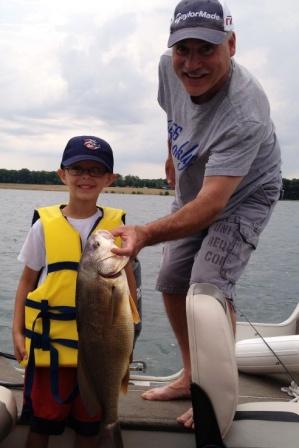 When
I was coming home from the coffee shop after chatting with the guys and
listening to some fishing stories the other day, one of my neighbors,
Dan Argona, was in his driveway fiddling around with his boat. I
stopped, and asked him how the fishing was treating him lately. He
couldn’t complain he said, it was a little bit slow, and we both agreed,
probably because of the high temps we are experiencing, might be what is
making the bass sluggish and not too hungry. “But I’m still catching
fish” he said, and the little moss that was there didn’t seem to matter.
Dan got a new Crestliner boat last year that is worthy of the Lake
Ontario chops and his boat never sits too long. He has it all equipped
for Spring trout and salmon fishing, and now that the bass season is
here, Dan has been trying his luck with Bass in the river and the mouth
of the river, and on the bar in the lake. He often takes his brother or
another friend out fishing, and privately, I regard him as the newest
Lake/River Guide because he has been so successful in such a short time. When
I was coming home from the coffee shop after chatting with the guys and
listening to some fishing stories the other day, one of my neighbors,
Dan Argona, was in his driveway fiddling around with his boat. I
stopped, and asked him how the fishing was treating him lately. He
couldn’t complain he said, it was a little bit slow, and we both agreed,
probably because of the high temps we are experiencing, might be what is
making the bass sluggish and not too hungry. “But I’m still catching
fish” he said, and the little moss that was there didn’t seem to matter.
Dan got a new Crestliner boat last year that is worthy of the Lake
Ontario chops and his boat never sits too long. He has it all equipped
for Spring trout and salmon fishing, and now that the bass season is
here, Dan has been trying his luck with Bass in the river and the mouth
of the river, and on the bar in the lake. He often takes his brother or
another friend out fishing, and privately, I regard him as the newest
Lake/River Guide because he has been so successful in such a short time.
In our little chat, he said to me how he enjoys my
articles in the weekly Sentinel, and likes how at the end of my articles
when I always suggest to whomever is reading it, to “Take a Kid
Fishing.” Well, he did, and the experience was more than words can
express. Dan took his son, Phil, Phil’s friend, Justin Tomaszewski and
Justin’s son Tyler, six years old fishing one day. Little Tyler had
never fished before, and for his first time ever fishing, and from a
boat. The quartet fished around for a while, and when the first fish
hit, Tyler had the honor of reeling in the first of the day, with the
help of his dad. The next bass caught was a muscular 3 pound smallmouth
bass, and Tyler was handed the rod & reel to wrestle this scrappy finned
critter, and shortly after hooking it, the 6 year old said, “dad, you
have to help me!” It was a tough one for a youngster at that age.
The third and biggest fish of the day happened to
be the fish you see in the picture. It is a good sized sheephead,
[freshwater drum] and considered by some to be the world’s most useless
fish. Not true. They were put in our waters by our creator, and he knew
what he was doing. When fishing is slow, slow, you can always count on a
sheephead swimming by, and giving you a thrill at the end of your line,
not knowing what it is until you fight it up to the side of the boat.
Bring it in the boat and usually it will croak similar to a frog, and I
have seen grown men stand back from one, wondering what the heck that
noise is, shy about getting too close. Not to get too technical, the
noise is believed to be made from the fish’s earbone, called an "otolith."
People think these fish are not good eating, well, they don’t taste like
a bass or walleye, but if you put them on ice immediately, clean them
like any other fish, and being an oily fish, they are actually good
smoked. The way I have had them after being smoked, is chopped up like
you would a tuna salad, with the same ingredients, and spread on
crackers. After you try one, you will want to keep one once in a while
for a tasty snack on your next fishing trip. Carp can be done the same
way. I know what some of you guys are thinking; you want to ask “how do
I get them lit to be able to smoke ‘em?” Ha, old joke.
Let’s get back to Tyler, the newest fisherman
joining our ranks. Dan said, “Tyler had his hands full and gave it all
he's got” when tackling the surprised sheephead, and it turned out this
youngster wasn’t about to give up. After this “croaker” got in the boat,
Tyler was exhausted and said, “I think someone has to get the next
fish.”
Dan said, “I had more fun watching him and seeing
his excitement! Priceless, is the correct phrase! I think we have a new
fisherman on board.” The newest fishing Guide, Dan Argona, added, “this
will be a day Tyler will never forget” then after thinking, he added,
“it’s a day I’ll never forget!”
There ya go! Go to it. Find a kid then take them
fishing, and it doesn’t always necessarily, need to be a boy, girls love
to fish too. Believe me. Always remember to bring a camera!
Comments and suggestions,
email me at [email protected] or contact the Sentinel at
[email protected].
As a footnote; those “otoliths,” also known as earstones, work on
a fish much like our own ears, helping us keep our balance and navigate.
All freshwater fish have them. In the early days, this small, hard
oval-like material was crafted into prized lucky charms, and worn around
the neck. TOP |
|
Outdoors in
Niagara
Mark Daul
Picture is of Danny and son Jesse
Bass Fishing – A Niagara River
Adventure – Coast Guard Encounter
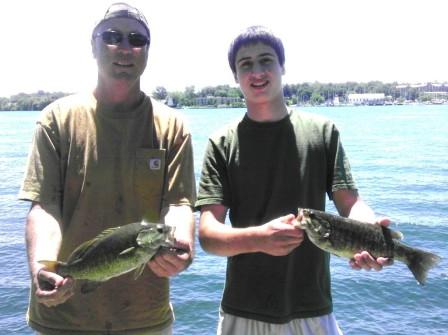 Last Saturday my grandson Jesse, son Danny, and I
went on a little fishing excursion for bass on the Lower Niagara. It was
a bright, no wind, and event filled day as it seemed the fish wanted to
show off. Danny latched onto the first fish, and it was a monster.
Apparently, he was fishing with a dull hook because he got it to the
edge of the boat and the fish winked at him, jiggled his head, spit the
hook, and swam away. He must have told the others to watch out for
plastic motor oil colored tube jigs and to don’t be fooled, stay away
from those things. After that, the little ones that didn’t listen would
come around once in a while and bite one. They were put back in the
water while we waited, for the big boys. Forty minutes later the bigger
guys moved in and we invited some for dinner. Six of them came. Last Saturday my grandson Jesse, son Danny, and I
went on a little fishing excursion for bass on the Lower Niagara. It was
a bright, no wind, and event filled day as it seemed the fish wanted to
show off. Danny latched onto the first fish, and it was a monster.
Apparently, he was fishing with a dull hook because he got it to the
edge of the boat and the fish winked at him, jiggled his head, spit the
hook, and swam away. He must have told the others to watch out for
plastic motor oil colored tube jigs and to don’t be fooled, stay away
from those things. After that, the little ones that didn’t listen would
come around once in a while and bite one. They were put back in the
water while we waited, for the big boys. Forty minutes later the bigger
guys moved in and we invited some for dinner. Six of them came.
I’m sure you have all heard of the stories about
the guy in the front of the boat gets all the fish while the guy in the
back struggles. Well, I was the guy in the back. The guy in the middle
was my grandson, Jesse, and he struggled with me. It was the guy in the
bow with the hot hand. If we turned the boat around, putting the front
where the back was, it was the same, the guy in the bow was nailing
them. I just can’t figure that out. Jesse did well, as he enjoyed the
ride, while listening to his father’s advice on how to jig his rod, and
how to concentrate. It didn’t matter, same bait, same place, same
results for him, nada.
While we were fishing, we saw the Coast Guard
checking boats, and eventually they came around to us, pulling up
alongside of our “vessel,” we were greeted with, “how’s the fishing?”
After that introduction, they asked, “when was the last time your boat
was boarded?” [for inspection] Captain Danny of our vessel, told him
“about two weeks ago.” They wanted to know if we had the paper showing
it was boarded. Our Captain showed it, the young Guardsman passed it to
his commanding officer, or coxswain, who inspected it with a magnifying
glass, handed it back and thanked us. Then all they wanted to see was
three life preservers, after that we chatted. Part of that conversation
was about why the Canadian law enforcement officials are pulling
American boats over that wander into their waters. They said our U.S.
State Department has been working on it, trying to resolve this issue in
someway, but the Canadian officials have not responded. We questioned
about not landing, and just passing through. They told us if you wander
over there, don’t shut off your engine to drift or anything like that,
just to keep your motor running. Never thought to ask about sailboats
moving with their sails only. When the Coastguardsmen were getting ready
to part, they said “please start your engine so we can hear it.” By
that gesture they wanted to make sure they weren’t driving away leaving
us stranded, I suppose.
We continued to fish along the shore just north of
Joseph Davis Park near the pipeline that comes from CWM, which is a good
hotspot, and is frequented by smallmouth bass. For naysayers, the
pipeline has no water flow now and when it does, it’s like one day, once
a year. I remember when that pipeline was going in, a CWM official
saying that water coming out of there was so pure, he offered to drink a
glass of it for his audience. He’s not with us anymore, and I often
wondered if he ever did take a sip.
After we caught all the fish in that location we
decided to take a trip to the Coast Guard drift, and try our hand there.
As we traveled north, we spotted two boats together near the middle of
the river, and we thought they were partying. As we got closer, we saw a
large black pontoon boat with small blue lights flashing and a tiny,
what looked like, a 4x6 maple leaf flag on a stick, waving off the
stern. Yup, some American citizen, a dad, with is wife and young son
about 8 yrs. old were pulled over, and being questioned/harassed by the
Canadian authorities. Maybe dad took them out and they were fishing on
New York’s Free Fishing Days weekend? [June 23-24] We were wondering how
many others have been pulled over today and ticketed or fined. Sometimes
I wonder if all this continued enforcement is in the name of Canadian
Homeland Security or if it’s just another money grab, trying to balance
the budget. I’ll bet it’s the latter. For you that don’t have a clue
where the international border line is, get a map or Google it. One
example, where the Youngstown sailboats are moored, there is a thin
strip of water between them and the border. Look it up.
Anyway, as we approached Youngstown, the water had
whitecaps on it and it was too rough for our boat with the wind blowing
from the west, so we headed into the ramp. We only kept one limit and
took it home, cleaned them, and had a fresh smallmouth bass dinner with
some leftover macaroni salad my wife made the day before. Well, she
called it macaroni salad, but it had everything in it but the kitchen
sink, and that included tuna fish, and Green Giant peas. Umm, no more
leftovers.
One last thing, Our U.S. Guardsmen don’t hassle
Canadians or others, only if landing on U.S. soil, then it is handled by
the U.S. Border Patrol. I would really like to compliment our Niagara
Station United States Coast Guard for being so courteous and efficient,
in doing the job they were sent out to do. When they come up to you,
greet them as they will surely greet you, but have all your safety
things ready and up to date and you’ll be on your way in a flash. Also,
I live by the lake, and I frequently see those young men out there in
any weather, any time, searching for, or saving lives, risking their
own. Good to have you around! Thank You.
TOP
|
|
Outdoors in
Niagara
Mark Daul
Picture is of Steve Drabczyk tossing feed
pellets to baby fish
IS IT A STEELHEAD OR A RAINBOW
TROUT?- Niagara River Anglers Pen
Rearing
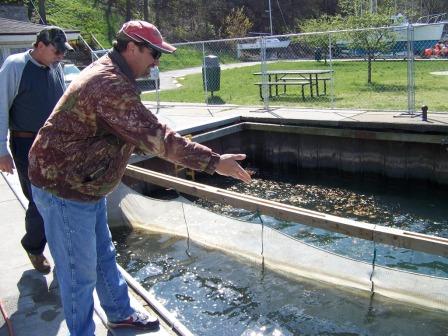 OK,
you heard it here. What is a steelhead trout and a rainbow trout? Around
here in our watershed, you could say they are the same, and people like
to call them all “steelhead” it just sounds better maybe. Genetically
they are both the same. A rainbow trout is a trout that spent its
entire lifetime in freshwater and a steelhead is a fish that grew up in
saltwater such as the Pacific Ocean, and come back to streams to spawn.
Now I’m going to confuse you. All steelhead are rainbow trout, not all
rainbow trout are steelhead. Steelhead is the name given to rainbows
that migrate to the ocean, [Pacific, in particular] grow, and come back
to the streams to spawn. Got that? Confused? Really, who cares at this
point but to simplify, if the fish did not have access to the Pacific it
would be called a Rainbow trout. Who cares anyway? Ask ten different
fishermen and you will get ten different answers. They look the same,
catch the same, cook the same, and are fantastic on the palette, baked,
smoked, fried, on the grille or even canned. Fresh run trout are a
gorgeous looking fish, and I feel only a brook trout could surpass it
for being the best looking freshwater fish in the universe. OK,
you heard it here. What is a steelhead trout and a rainbow trout? Around
here in our watershed, you could say they are the same, and people like
to call them all “steelhead” it just sounds better maybe. Genetically
they are both the same. A rainbow trout is a trout that spent its
entire lifetime in freshwater and a steelhead is a fish that grew up in
saltwater such as the Pacific Ocean, and come back to streams to spawn.
Now I’m going to confuse you. All steelhead are rainbow trout, not all
rainbow trout are steelhead. Steelhead is the name given to rainbows
that migrate to the ocean, [Pacific, in particular] grow, and come back
to the streams to spawn. Got that? Confused? Really, who cares at this
point but to simplify, if the fish did not have access to the Pacific it
would be called a Rainbow trout. Who cares anyway? Ask ten different
fishermen and you will get ten different answers. They look the same,
catch the same, cook the same, and are fantastic on the palette, baked,
smoked, fried, on the grille or even canned. Fresh run trout are a
gorgeous looking fish, and I feel only a brook trout could surpass it
for being the best looking freshwater fish in the universe.
The Niagara River Anglers Association, in
cooperation with the NY DEC on Thursday April 12, stocked 10,000
fingerling [baby] steelhead in their rearing pen that is located in
Youngstown at the Youngstown visitor’s overnight boat slip. A fingerling
is about as long as your finger. A mans finger that is, and ladies, you
won’t qualify. If you want to see this operation, take a ride down Water
Street and just before you get to the bottom of the hill, make a sharp
right. Go down that short road to the end and the project is right
there. Drive very slowly down that road as workers are putting boats in
their moorings for the season. Don’t go in the fenced area to the pens.
The Anglers is one of the pioneers in pen rearing
trout and salmon in New York State. There are a total of seven projects
dotted all across Lake Ontario from Rochester to the Niagara River and
all managed by volunteers from fishing clubs. Plus, there are a group of
guys in Wilson NY that is headed up by Captain Mike Lis, Wilson
Councilmember Brad Clark and a handful of dedicated volunteers. They
manage a highly successful project as does the dedicated members of the
Lake Ontario Trout and Salmon Association [LOTSA] who have been doing
this for several years also.
The reason for volunteers to work so hard and give
of their time in rearing projects is to maintain a fishery for their
sport, and down the line, hopefully, many of these fish will spawn
naturally creating an even better fishery for future generations.
The reason for pen rearing is that these fish,
[salmon too] get imprinted to the waters where they were raised as
babies other than the fish hatchery, grow into what they call “smolts”
[a little more grown up] then they move out to the big waters of the
lake, grow, and return to the waters they came from to reproduce and
complete their life cycle. Scientists call that “homing” Each stream has
a unique chemical composition, a distinctive odor, and somehow they
return home with the help of their maker in the sky. Anyway, that’s all
you need to know for now about imprinting and “smolts.”
I visited the NRAA pen project this week with its
project volunteer chairman Captain Steve Drabczyk from Lewiston, and his
right hand man, Ed Garcia. Drabczyk told me it will be about another
approximately 2 more weeks before these fish will be released. They have
already grown about two inches since being put in the pen Drabczyk said.
These pen projects are a very intensive project that requires planning,
preparation of pens before the baby fish arrive, and then after they
arrive they need to be fed five times a day, every day, starting at 7:00
am, every three hours by an army of feeding volunteers. The feeding
schedule needs to be strictly followed. They are fed prepared fish
pellets like they get in the hatchery, and that trains these little guys
to feed on their own so when they reach the wide open waters, instinct
takes over and off they go fending for themselves. Feed is measured out
ahead of time so as they grow, and requiring more feed, they get the
proper amounts that are pre-planned by DEC biologists. If you would like
to help in any of these projects, these volunteers would love to add
even more volunteers. Email me and I can put you in contact with any of
these fish masters.
The Anglers pens, in a couple of weeks or days,
will see an additional inoculation of Chinook [commonly known as a King]
salmon in their other side-by-side pen. These babies will be fed,
imprinted, and released in the same way as the steelhead [Steelies] are,
and then released in about 3 weeks to go on their merry journey, all in
tip-top shape and all imprinted. The average, freshwater raised,
lifespan of a Chinook salmon is 3 to 4 years, and most common size
caught in New York State is between 15 and 35 pounds; however the NYS
record King was weighed in at an astounding 47 pounds, 13 ounces, in the
Fall of 1991.

“So what, if you have caught a
Rainbow trout, it may also be a steelhead.”
Smolt about to be released >
TOP |
|
Outdoors in Niagara
Mark Daul
Eating Crow…….really
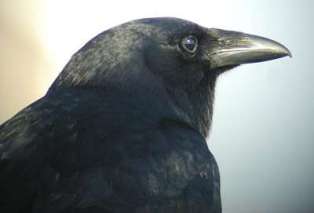 Sometime
ago, I wrote this story about crows. My story routine is, I hand it to
my wife for story content, and to make sure all the T’s are crossed and
the I’s are dotted. When she finished reading it, I said, “well?” she
crinkled her nose, and said she didn’t think the story was interesting
enough. A couple of weeks later I was sitting with a couple of guys
shooting the breeze, and a crow conversation started. I told them about
this story I wrote, and they were all ears when I told them about it.
When I went home, and after thinking about it, I dug the story up out of
my computer, and I thought if these guys thought crows were interesting,
then others should be too. So, here it is: Sometime
ago, I wrote this story about crows. My story routine is, I hand it to
my wife for story content, and to make sure all the T’s are crossed and
the I’s are dotted. When she finished reading it, I said, “well?” she
crinkled her nose, and said she didn’t think the story was interesting
enough. A couple of weeks later I was sitting with a couple of guys
shooting the breeze, and a crow conversation started. I told them about
this story I wrote, and they were all ears when I told them about it.
When I went home, and after thinking about it, I dug the story up out of
my computer, and I thought if these guys thought crows were interesting,
then others should be too. So, here it is:
Crows always fascinated me since I was a young kid.
The neighbor down the street had a pet crow called “Ansy” and a pet
rabbit. They both were well taken care of, but it was Ansy that always
had my attention. I swear that crow knew me when I would come around to
the back of the house. It would get excited when he or she would see me,
and my dog, Pete. It would start talking and saying things like
“hellooo” or “hie” for hi. Or sometimes it would “chirp” fluctuating
between high tones and low tones, probably mimicking other backyard
birds. It also seemed like it would ask me, “what time is it?” I never
knew if it was a he or she, but it was a cool bird. At that time, my
mother had parakeets, and they had a much larger vocabulary than this
crow, but it was the crow that had my attention. Ansy had a great big
homemade cage that was fastened to the porch railing. It didn’t fly
because its wings were clipped so it couldn’t, but it sure could get
around with short flights and hops. It would flutter down off the porch
railing, hop over to me, follow me around, and be my friend. It liked
Pete, and Pete was pretty proud that Ansy would allow him to give
him/her a ride. Pete was a medium sized mongrel, kind and gentle.
Sometimes they would just stare at each other and Ansy would repeatedly
say hie. I knew where the food was kept, and Ansy knew that I knew. It
would stand tall, look at me, spread its wings out, make talking noises,
and let me feed it and pet it. I felt we bonded whenever I visited, and
it sure liked my peanuts when I brought them, but dry dog or cat food
was a regular diet feed for this birdie. [And the rabbit too.] I am sure
when it squawked and cawed, it was telling me something, and sometimes I
guess I would make up in my mind what it was saying, and I would talk
back. When our visit was over, I would apologize and tell him he had to
go back in its cage, and understanding me, I would guide him back to it,
and he would gladly hop right back in.
The story about how Ansy became a pet, was that the
neighbor found this crow when it was very young on the ground apparently
falling out of its nest, but no nest was visible, and suffering some
kind of trauma. He comforted it, nursed it, and they became friends.
However, it is not recommended to rescue any wildlife because sometimes
they are better off being left alone, and, rescuing Ansy was back in the
“old days” maybe before laws were made to prevent illegal possession of
wild creatures. The belief, at the time, was Ansy would be able to talk
better if his tongue was split, but that seemed to be cruel and mean, so
my neighbor never did that. Ansy eventually talked anyway.
During the fall and winter, just before dark, a
couple of my friends and I would venture out to the Niagara Falls Golf
course [Hyde Park] at the very end of North Avenue. Across the green
there was a woods where the creek would flow through, and at night the
crows would gather in huge flocks, probably in the thousands, way up in
the trees where they would make all kinds of noise cawing among one
another, just socializing. We would make crow noises back at them and
all of a sudden all those crows would turn silent for a few moments then
start socializing all over again. We thought that was fun. It is said
crows are the most intelligent birds in all of North America and I am a
believer. A flock of crows is called a “murder” of crows to be precise,
and that has a good story too. Folklore has it that crows will gather
and decide the death of another crow, and the other thought is, that
they would circle in large numbers where other animals or people were
expected to die.
Crows are very sociable, often when you see them in
groups, they are families. Crow, are seen all over North America and
around here you will see them in corn fields, golf courses and other
places, including your backyard, and you often see them on the road
feeding on a dead mouse or other kind of carrion, but they will eat just
about anything. On the roads you might see one or two feeding on
carrion, and maybe three, four or more, sitting up on the power lines
looking down waiting for their turn, more than likely, they could be
siblings.
They say wild crows don’t collect shiny objects
but, Ansy would collect mostly bottle caps, and it would especially like
Christmas tree tinsel it would find in the gravel driveway. Back then
most Christmas tinsel was made of fine shiny metal strips like lead.
Ravens are the birds that love to collect. They’ll find things from
anyplace and hide them somewhere. Ravens and crows are identical in
color and shape, but the raven is about 1/3 larger in size than its
counterpart.
Hunting Crows in New York State is legal, and a
hunting license is required. It is legal from September 1 to March 31
and only from Friday thru Monday from sunrise to sunset between those
dates. Besides shotgun, rifles are permitted on hunts. Although the PETA
people are against killing crows or anything else that has “meat,” crow
hunting is considered a great sport and a necessary one for controlling
these sometimes huge flocks that can become destructive, and a vehicle
to support various diseases such as the West Nile Virus. Hunters call
crows with mechanical hand callers or with electronic bird callers, and
are quite successful. Even predator callers are successful into making
the crows think a predator just made a kill, and now there is something
for all to eat. Calling crows can be fun and a great adventure for
youngsters, and spring will be here shortly so that is the time to get
out, look around you and see what Mother Nature brings you. It’s also
time to get to your sporting goods store, and take a look at the crow
decoys and calling aids that are available, and even learn your own hand
calling techniques. Don’t forget to take the young‘uns. Discover the
outdoors!
So, the crux of my story is, yes, I ate crow once,
have you? Delectable. /Comments to this story: email
[email protected]
More articles on our archived
page HERE
|
|
|
Outdoors in
Niagara
Mark Daul
Picture below submitted by Joe DiMino, Lewiston,
taken with his trailcam
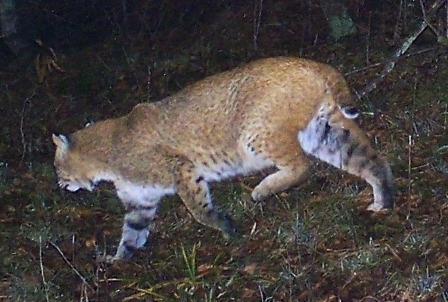 Residents
Report More Bobcat Sightings …… Maybe Canada
Lynx? Residents
Report More Bobcat Sightings …… Maybe Canada
Lynx?
From the
time I wrote the bobcat article until now, a lot of people have come up
to me and said “gee, I think I’ve seen one of those things too.” I
agree, they are so fast, it is hard to believe your eyes if you do see
one.
Needless to say, I feel a lot better after writing in the Sentinel about
bobcats in the Niagara area. Now I know I’m not alone about what I saw.
My friend, Mike Gillis, should rest easier too, knowing that our
sightings collaborated our stories with what we saw were bobcats.
The
emails and replies were fantastic as you can see, as you read down
further.
Someone
asked about the Canada Lynx being mistaken for a bobcat. Yes, they
could, but highly unlikely to be found around here. They are similar in
appearance, same food habits, same delights for dinner, and habitat the
same, and they even have the short tails and the pointed ears with the
black fluff at the tip. They are a little larger in size, but extremely
rare in New York State. The U.S. Fish & Wildlife Service [USFWS] has
them on the endangered species list all across the
contiguous
United States, since early
2000. They are more docile than the bobcat, and habitat destruction, and
competition with the more aggressive bobcat as the reason given for
being on the endangered list. Obviously, bobcats are more adaptable to
their surroundings.
George
Green, a Lewiston resident who lives on Mt. Hope Road, between
Garlow and Walmore roads, sighted one in his back yard, and his wife,
and daughter are witnesses. George said he has deer and other wild
creatures visit his backyard, and the night of his sighting, he went out
on his back porch with his night vision scope to see what he could see,
and he saw an animal on the hill in the back. George said he looked at
it and thought, “What the hell, looks like a bobcat!” He called his wife
to take a look and asked her what she thought it was. “As she was
looking through the scope, I stepped out on the porch that turned on the
motion light, and it lit up the area, and sure enough it had the
brownish color and lighter colored belly, little tail and pointy ears.”
George said, “the light went out and we waved to turn it back on, but
the animal had gone on the other side of the hill, and all we could see
were eyes and ears.” George’s mother lives next door, and has chickens,
and she had noticed some have been missing lately. She said some roost
in a small tree, and some roost in the barn where the door is always
open. Aha, just what these critters eat for their midnight snacks!
Chicken! I’ll bet that barn door will be closed from now on.
Joe Kilmer
emailed me and said he saw the bobcat article in the Sentinel, and it
jogged his mind about his story. In mid October, Joe and his wife
Marie, went out one evening around 10:00 o’clock on their way to
Bandanas for a bite to eat. They left Youngstown via Main Street, to
Jackson Street, as they approached the curve to Old Lake Road, he
started to accelerate and saw eyes glowing in the road way. The object
was low to the ground, no tail, stubby face and pointy ears, it happened
so fast. It was heading into the Fort, and he said, “I could not
believe what I thought I saw or did not see.” First, he thought it was
it a fox, and turned around as fast as he could while explaining to
Marie what he thought he saw. Joe said he pointed the car into the road
to the Fort with his headlights shining, and saw nothing, it was gone
that fast. Joe said, “I might have doubted what I thought I saw until
today after reading your article. I have also doubted my wife’s and
father-in-law’s sighting less than a year ago in the back field behind
his house on Dickersonville Road, south of Langdon Road.”
Joe DiMino,
from Lewiston, and I talked, and he reported recording bobcats three
different times on his trail cam, at his hunting cabin down near
Wellsville NY. He said the first one he saw was recorded on his
Trail-Cam in August just this past summer, and another in October, then
the third in November. Also in November, while he was bow hunting, about
25 yards away, one ran across his path. He said it went so fast he
couldn’t get his camera out of his fanny pack quick enough, but he knew
right away what it was.
Jim White emailed me
and said one crossed right in front of him on Upper Mountain Road a
while back, and there is no mistaking it was a bobcat. White also said
there were reports of a Black Panther in the area, but that is highly
unlikely here in NYS according to the NYS DEC: “No cougar [AKA panther,
puma, cougar] sightings documented in New York State.”
Thanks to everyone
that responded to the bobcat story, it was very interesting for sure,
and it was fun doing it.
Lewistonian, Jerry
Farrell, and I, attended a Niagara Pioneers Sportsman’s Club meeting
recently, and he gave the members a quick synopsis of his purple martin,
and other bird tagging activities over the past 25 years at the 3-F Club
on Swann Road. I made notes, and took in as much as I could, and asked
Jerry if I could contact him if I have anymore questions regarding his
purple martin tagging efforts for a future Sentinel article. Being the
sportsman, and the only federally licensed bird bander in the area, he
agreed wholeheartedly. Watch the Sentinel for a purple martin tracking
story reported by a nationally, and internationally known local bird
expert.
Fishing updates can
be found on
www.OutdoorsNiagara.com and if you would like to add your thoughts
or would like to read others thoughts on the local fishing scene, follow
the link to the Outdoor Forum. On the website you will find an archive
of Sentinel Outdoor Stories. If you have something you would like to add
here please email me at
[email protected]
TOP
|
Are There Bobcats in Niagara?
Outdoors in Niagara
Mark Daul
 I
recently wrote an article for the Sentinel about Coyotes. I met a friend
in Youngstown at Melloni’s Market Place, and he told me he had read the
article, and asked if I heard anything about bobcats in the Niagara
area. That discussion brought me back to a time when I thought I saw one
on the roadway, about 150 yards away looking at me from the road. I
didn’t see the whole animal up close, nor did I recognize it from that
distance, and it looked like an overgrown housecat or a stray field cat,
but as I drove closer it sauntered off into the field at the side of the
road. I kept my eye on that spot, and as I approached the area where it
disappeared, then all of a sudden I could see its hind end and the short
tail, and in about two jumps, it was gone. About a month or so after
that, I was in Bandana’s on Lake Road, and a friend and I got into a
conversation about different things, and he mentioned he spotted what he
thought was a bobcat near his house, but had only gotten a glimpse also.
We both live in the same general area around Bandana’s, and our
description of what we saw were similar, short spotted tail, and
brownish hind quarters. After our sightings, I did some investigating
with area sportsmen/hunters to learn if they ever spotted any creatures
around here that would meet that description, and no one ever even heard
of one around here. Time has passed and I forgot all about my sighting
until my friend in Melloni’s Market asked me about these ‘cats. I
recently wrote an article for the Sentinel about Coyotes. I met a friend
in Youngstown at Melloni’s Market Place, and he told me he had read the
article, and asked if I heard anything about bobcats in the Niagara
area. That discussion brought me back to a time when I thought I saw one
on the roadway, about 150 yards away looking at me from the road. I
didn’t see the whole animal up close, nor did I recognize it from that
distance, and it looked like an overgrown housecat or a stray field cat,
but as I drove closer it sauntered off into the field at the side of the
road. I kept my eye on that spot, and as I approached the area where it
disappeared, then all of a sudden I could see its hind end and the short
tail, and in about two jumps, it was gone. About a month or so after
that, I was in Bandana’s on Lake Road, and a friend and I got into a
conversation about different things, and he mentioned he spotted what he
thought was a bobcat near his house, but had only gotten a glimpse also.
We both live in the same general area around Bandana’s, and our
description of what we saw were similar, short spotted tail, and
brownish hind quarters. After our sightings, I did some investigating
with area sportsmen/hunters to learn if they ever spotted any creatures
around here that would meet that description, and no one ever even heard
of one around here. Time has passed and I forgot all about my sighting
until my friend in Melloni’s Market asked me about these ‘cats.
When I got home my curiosity made me Google bobcats in New York.
These wily, secretive felines are interesting and live a good life,
mostly nocturnal, but can be seen in daylight at times, and sighting one
is extremely rare. Their diet is similar to a coyote, believe it or not:
rabbits and rodents, birds, insects, even fish and they have been known
to prey on deer just like its coyote friends in the wild. They are
natural born survivors and live around 12-13 years, and according to
some sources, 6 to 8 years. Males are usually between 32 and 37 inches
long and weigh about 28 pounds. The ladies of this species are anywhere
between 29 to 34 inches and the petite little things hit the scales at
an average of 15 pounds. It had to be a male that I spotted, it was big.
From descriptive pictures I have seen, colors vary from yellowish
brown, light gray, reddish brown, and buff brown, probably like the one
I saw the back end of. They are spotted along the sides, some more than
others, and the tail is between 6-8 inches, multi colored, spotted,
black on top and white on the bottom. “Bobcat,” so called because of
it’s “bobbed” tail. The face is cute and bright looking, with furry
black tufts at the top of their sharp pointed ears, long fur at its
cheeks and whiskers like your domestic cat. They like to make their
homes in secluded places like rock piles, brush, hollow trees & logs and
ledges where they can pounce on their prey sight unseen. They don’t like
human activity and keep to themselves. Predators are few, deaths
occurring mostly from diseases [rabies] or from their prey, in self
defense. If you are out in the winter or spring you can tell bobcat
tracks by their looks and size. Showing four toes without claws they are
about two square inches, which are larger than you house feline, and if
they are running, the stride is between 4 and 8 feet.
Hunting and trapping bobcat is not permitted in Central and Western
NY, the eastern part of the state allows hunting and trapping but check
the laws. Season opens on October 25th.
So, are there bobcats in Niagara? According to the people I talk to,
it is highly unlikely, but what was it my friend and I saw? I think we
saw a bobcat, more than likely, we both saw the same one. I you have had
a sighting in your travels or spot one in your future travels, I would
be interested in knowing, please contact me. Maybe if you want to
actually see a live bobcat, you need to find a zoo with one, but if you
do have a sighting in the wild, by all means get a hold of the DEC
office in Buffalo and if you can, get a picture to verify your sighting
so it can be recorded. [Buffalo- 716-851-7201]
For up to date fishing reports in our area be sure to check out
www.OutdoorsNiagara.com
for the latest. Right now, steelhead fishing in the Lower River is going
quite well, if you are fishing from shore or boat, fishermen are using
eggs, egg sacks, Kwikfish and a variety of spinners and spoons. Wilson
and Olcott pier fishermen have been very successful. If you have
something to add contact me at
[email protected] or go to the Outdoors Niagara website and
you will find an archive of my recent Sentinel articles there on the
“L-P Sentinel” Page.
|
|
TOP
Outdoors in Niagara
By Mark Daul
A Grand
Island Fishing Opportunity
 Last
week, when it was so hot the trees were whistling for the dogs, my wife
and I took a little car ride. We were actually headed for the Canal Fest
in the Tonawanda's, but never got over the South Grand Island Bridge; we
got sidetracked by visiting Grand Island, a place I haven’t fished from
in years. I heard about the brand new fishing dock called Fisherman’s
Landing, located at the southern tip right near the south Grand Island
Bridge on East River Road. Hoorah! What a great place for shore
fishermen. I didn’t go there to fish, just to see what the place looked
like. There is handicap parking right near the dock safety rail, and
non-handicap parking is just above the hill. I could see down in the
clear water that this could be a bass haven for shore anglers just
outside the weedbed. When we arrived there was a lone fisherman named
Steve trying his luck. When I approached him and asked, “How’s the
fishing” He replied, “No fish, but fishing is good.” I thought, now
there is a person I could like, telling it like it is. I asked Steve if
he lived around here, he said “no, I’m from Depew.” “How did you find
this place Steve?” He replied, “I was driving over the bridge and
spotted this dock so I drove around to take a look, I had my fishing rod
in the car, went looking for bait, and found a gas station that had a
sign ‘Live Bait.’ I got some bait, and so far, I only caught a couple
tiny rock bass ” It was 94 degrees that day on the car’s digital temp
gauge, and the fish seem to lay low on days like that, just like people
do. Last
week, when it was so hot the trees were whistling for the dogs, my wife
and I took a little car ride. We were actually headed for the Canal Fest
in the Tonawanda's, but never got over the South Grand Island Bridge; we
got sidetracked by visiting Grand Island, a place I haven’t fished from
in years. I heard about the brand new fishing dock called Fisherman’s
Landing, located at the southern tip right near the south Grand Island
Bridge on East River Road. Hoorah! What a great place for shore
fishermen. I didn’t go there to fish, just to see what the place looked
like. There is handicap parking right near the dock safety rail, and
non-handicap parking is just above the hill. I could see down in the
clear water that this could be a bass haven for shore anglers just
outside the weedbed. When we arrived there was a lone fisherman named
Steve trying his luck. When I approached him and asked, “How’s the
fishing” He replied, “No fish, but fishing is good.” I thought, now
there is a person I could like, telling it like it is. I asked Steve if
he lived around here, he said “no, I’m from Depew.” “How did you find
this place Steve?” He replied, “I was driving over the bridge and
spotted this dock so I drove around to take a look, I had my fishing rod
in the car, went looking for bait, and found a gas station that had a
sign ‘Live Bait.’ I got some bait, and so far, I only caught a couple
tiny rock bass ” It was 94 degrees that day on the car’s digital temp
gauge, and the fish seem to lay low on days like that, just like people
do.
When I was talking to my new found friend, Steve, I
asked if I could take his picture while fishing or tossing his rod out.
He said, “no, I’d rather not.” I told him I write articles for WNY
Newspapers, and in particular, the L-P Sentinel. He still didn’t want
his pic taken so I looked him in the eye and said, “I’ll bet I know
why!” A big grin came across his face, and he said, “think so?” then I
told him, “I’ll bet you are playing hooky from work!” With a broadened
grin and a chuckle he said “Yup, you’re right!” So I let it go at that.
How many of us have done the same thing on a summer day.
After checking out the huge amount of tiny newborn
minnows and larger shiners traveling the edge of the dock, I thought,
with bait fish like this in here, there has got to be a load of
smallmouth bass lurking just outside the weed beds looking for a fast
meal, maybe even a northern pike or two. The picture showing the dock is
looking east showing the south bridge. Notice how nice the dock is paved
and the garbage receptacles placed there. Handicap parking is ground
level, just about where I’m taking the picture from. No seating, so
bring a lawn chair.
After our investigation of the new Landing, we
hopped in our car and headed down East River Road to Whitehaven to get
on the Thruway and pulled into a McDonald’s. Seemed like a good idea to
stop and get a bite at that time of day. We pulled in the parking lot
and spotted TC’s Tavern next door. Surely they have air conditioning and
food, so we drove through McDonald’s lot and right into TC’s. We were
greeted by Sarah, the very congenial barmaid, whom we found out later
was named “Miss Tease” by Dale, a patron who moved over to give us his
seat at the bar. I thanked him and told him we came in to cool off, and
he said “Yeah, it’s about time we got some nice weather isn’t it?” I
had to agree, our winters are just too long around here. In our short
stay, and being complete strangers, it seemed like we knew all the
people in there forever. To top it all off, Dale had printed across his
T shirt “Fandemonium” the favorite saying of Van Miller, the
former radio voice of the Buffalo Bills. Among the eats, TC’s has
burgers, chicken fingers, beef on weck, that Sarah says is outrageously
good and highly recommended. Looks like a good clean place for locals to
hang out with three flat screen TV’s, a pool table, darts, and a new
“Touchtones” internet jukebox. We’ll go back.
I suspect Grand Island people are reading this
column and not to sound like a broken record on this subject, but if you
fish or boat off the West and Southwest Island area, be sure you know
your border waters. Canadian law enforcement has been brutal. In a
nutshell, if travelling in Canadian waters, do not shut your motor off
and drift, you will be illegal according to them. Don’t touch the
underwater soil with a sinker or anchor or you will be breaking the law,
and subject to a $1,000 fine. If you plan on doing that, you need to
notify the system called CAN PASS. If you haven’t heard of this before
now, call this number 1-888-226-7277, and you can ask about it, and also
register at that number if you plan on entering or landing. I wonder how
this works out for the swimmers at Beaver Island. There, you could swim
out and immediately turn into a foreigner in another country. Silly
isn’t it?
I have a lot of great things to say about Grand
Island’s fishing opportunities and there’s no room in this column today,
but that will be a subject of a future column for sure.
Always remember one thing, take a kid fishing and
don’t by-pass the elders who can’t get out. They like fishing too!
Always bring a camera.
In case you were wondering, the Fishermen’s Landing
was paid for by Niagara River Greenway funds and the NYS Local
Waterfront Revitalization program.
In the photo above, it is showing the south Grand
Island bridge from the fishing platform
|
Coyotes that roam Niagara County
by Mark Daul
Outdoors in Niagara

Niagara coyotes are described as the
Eastern coyote (canis latrans), and
the theory is they migrated to New
York state in the late 1930s and
early '40s. In the 1970s they became
very abundant across the state, and
in some pockets they over-populated.
They are an admirable animal to
just sit and watch. Coyotes are very
smart, wily, adaptable, and good
hunters, eating small rodents and
rabbits, and in summertime they add
grass, berries, large insects and
birds at times. Coyotes are mostly
nocturnal, and they love cats that
are left out at night, so make sure
your pets are safe and sound.
Raccoons get blamed for a lot of
things that coyotes can get into,
and they can tip your garbage can
over in a jiffy and feed just like
the raccoons.
Coyotes are about 4 to 5 feet
long including the tail; about the
size of a mid-sized German Shepard,
and weigh 35 to 45 pounds with long
thick fur and bushy tail. Color
varies and the ones I have seen are
generally dark tan and black.
Coyotes may be seen alone or in
small groups. They are often spotted
crossing the Robert Moses Parkway
anywhere between Lewiston and Fort
Niagara, and oftentimes during the
day in late summer and fall, when
the adults send their offspring away
to fend on their own, find their
mates, and take up a new territory.
I live in a neighborhood where
there are virtually no dogs, and
many times this time of year, I go
out in the morning only to discover
piddle on my car tires and against
my shed and other objects in the
yard. It's a sure sign I had
visitors through the night marking
their territories. I have never seen
one in my yard, but I know it was
them casing my territory. I never
found any feces, but if I did I
would know what to look for, as it
is made up of what they eat; parts
of animal hair and bones, and pieces
of nuts and fruits, things they
can't digest. Through the winter
snow coverage they can hear a mouse
tunneling under many inches of snow
and then pounce on it for another
meal. In the spring time when food
gets scarce they have been known to
take down a new born fawn to get a
couple of meals out of, or even
freely eat off a dead deer along the
roadside.
Rabies are rare in coyotes with
only a few cases reported in New
York state. But they are known to
show aggressive behavior sometimes,
so you should always be cautious if
walking your dog through a wooded or
grassy area; they like to show off
their superiority toward other dogs.
You should report any aggressive
behavior to the state Department of
Environmental Conservation or a
nearby police agency and let them
handle it. Dogs and coyotes do not
interbreed.
Getting close to Mother Nature is
a great thing, and many of us are
blessed to be able to get outdoors
in Niagara to enjoy the solitude,
especially with winter snows
approaching where we can get out and
actually track a lot of winter
creatures. Coyote tracks can be a
little confusing; they look similar
to medium-sized dog tracks.
Sometimes when tracking you will see
where one caught his meal and a
scuffle ensued only to see feathers
and bones left. You may even hear
the eerie howls and yelps of the
lonesome coyote in the wind. (They
can be heard up to three miles away
on a quiet day or night and
favorable wind.)
These critters don't hibernate
and they hunt all winter. Hunting
them is regulated, and you can hunt
or trap them in New York state from
Oct. 1 to March 25. And you must
purchase a small game license to do
so. There are no limits on what you
take and you don't have to report
your harvest.
There is a wonderful story about
coyotes on the Outdoors Niagara
website written by local outdoorsman
Mike Gillis, a lifelong resident of
Youngstown. He goes a little more in
depth where he actually encountered
these creatures of nature. For more,
visit
www.outdoorsniagara.com/coyotes.htm.
TOP
|
|
More articles on our archived
page HERE
|
| NOTE: This article was a letter to
the editor of the Niagara Gazette on November 17 2011
More light on the ethanol fuel controversy
Mark Daul
Youngstown NY
Bob Confer’s column of October 11th pertaining to E-10 fuels was
unfairly attacked by Chris Thorne, Public Affairs Director of Growth
Energy. Who is “Growth Energy you might ask?” Growth Energy is a
proactive group of American ethanol producers……of course biased as I can
see. Confer was merely expressing pitfalls of EPA mandated E-10 fuels
and warning of the approaching E-15 fuels that are being blamed for
costly repairs to some older motor vehicles in particular outboard
motors, lawnmowers and such. Confer related the rising prices of food,
and Thorne disputes that fact, but that is a whole different argument.
Neither Confer nor Thorne addressed the real problem and that is with
fuel separation and shortened fuel storage life which happens in
gasoline containing 10% ethanol or even the E-15 [15%] that will soon be
crammed down our throats.
Phase Separation describes what happens to gasoline containing
Ethanol when water is present. When gasoline containing even small
amounts of Ethanol comes in contact with water, either liquid or in the
form of humidity, the Ethanol will pick-up and absorb some or all of
that water. When it reaches a saturation point, the Ethanol and water
will Phase Separate, actually coming out of solution and forming two or
three distinct layers in the tank. This separation it is said, can occur
anywhere from within two weeks to ninety days. Once separation has
happened in your tank, the only way to eliminate it is to completely
drain the tank and start over with fresh fuel.
In older engines Ethanol-Blended gasolines can raise havoc, but Mr.
Thorne didn’t mention that either. However, he did say “Ethanol is a
high-octane solvent; and will actually keep your engine cleaner than
older MTBE fuels, extending the life of your boat or outdoor engine.” [MTBE
replaced lead as an octane enhancer]. He didn’t say older motors [eg.,
boat motors prior to 2007] can be destroyed by metal corrosion,
deterioration of rubber and plastic fuel components resulting in clogged
fuel filters, carburetors and in some cases, fuel injectors. He didn’t
say anything about composite fuel tanks being weakened, or lowered fuel
mileage, this means that the more Ethanol found in fuel the worse your
fuel economy will be. You use more gallons of fuel containing Ethanol to
go fewer miles. Another note here is the Federal Aviation Administration
along with some engine manufacturers, has prohibited the use of
automotive Ethanol-Gasoline blended fuel due to safety issues and engine
damage.
I have to agree with Mr. Thorne about these blended fuels creating
“jobs that can’t be outsourced”. I can assume it has created thousands
of U.S. Ethanol manufacturing jobs just like engine repair shops are
going full steam repairing motors that can’t take this product even
though it has been marketed since the 1970’s, but back then we had a
choice. Now the EPA mandates that since January 2011, all gasoline
stations carry Ethanol laden fuel. According to the New York Times,
[July 2011] “Food manufacturers and cattle and chicken farmers say the
government’s support for Ethanol is, in effect, pushing up food prices.”
But not so, according to Chris Thorne, who said, “There is no evidence
that Ethanol results in higher food prices”. I guess it all depends on
who you want to listen to, a newspaper writer or a proactive group of
corn/Ethanol producers.
Field corn was projected by the USDA at $3.25 per bushel in 2007-2010
compared to $2.00 a bushel in 2000-2005. Fuel blenders have been getting
Federal Government subsidies to the tune of 6 billion a year. Those
subsidies come from our pockets. But wait! The Senate voted 73-27 in
June to cut annual tax credits for blenders of ethanol. The vote was
largely symbolic since the amendment was attached to a bill that failed.
There was talk about fuel being blended right at the gas pumps, but gas
station owners are reluctant, even though the Feds want to give out
grants to subsidize them. Oh, more subsidies!
Whatever way you look at this problem, remember “Phase Separation” is
a mean result of this blended fuel and if you are storing your lawn
equipment, motorcycle, boat or whatever, remove all the remaining fuel
you have in your tanks and start fresh next season. One thing you can do
for a short term is close off all tank vents and that will help prevent
outside air moisture from entering and spoiling what you do have. The
only good fuel additive that I am aware of is K-100 by Kinetic Labs.,
and is available in many local gas outlets. However, don’t wait until
you have the problem, it won’t work; use it regularly to prevent the
problem.
TOP |
NOTE: If you came to this page looking for the Fake Wolf-dog story, it was
deleted as it was OLD news and yes, a fake.
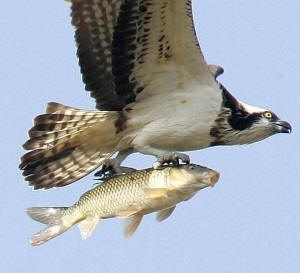 Osprey
living among us
Osprey
living among us



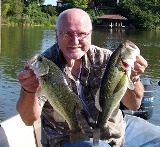 A
Note from Mark Daul: The Lewiston-Porter Sentinel is a free weekly paper
[Saturdays] under the umbrella of Niagara Frontier Publications [NFP] and
distributed to homes and businesses from throughout the area and touts itself as
"WNY's best local coverage". The LP Sentinel is one of three local papers
under this umbrella and the others are the Grand Island Dispatch and the
Niagara-Wheatfield Tribune.
A
Note from Mark Daul: The Lewiston-Porter Sentinel is a free weekly paper
[Saturdays] under the umbrella of Niagara Frontier Publications [NFP] and
distributed to homes and businesses from throughout the area and touts itself as
"WNY's best local coverage". The LP Sentinel is one of three local papers
under this umbrella and the others are the Grand Island Dispatch and the
Niagara-Wheatfield Tribune. When
famous Country singer George Jones passed away recently at the age
of 81, the TV and radio broadcasters went with the tag name Jones
earned during his career as “no show Jones” because in his younger
years he had an alcohol problem, and didn’t show up for some of his
shows. The other tag name he earned was “The Possum” which was
supposedly an inside joke about his looks, or facial features. I
could never see that but there it was.
When
famous Country singer George Jones passed away recently at the age
of 81, the TV and radio broadcasters went with the tag name Jones
earned during his career as “no show Jones” because in his younger
years he had an alcohol problem, and didn’t show up for some of his
shows. The other tag name he earned was “The Possum” which was
supposedly an inside joke about his looks, or facial features. I
could never see that but there it was.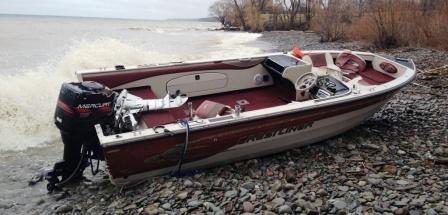 No
doubt everyone in the area heard about the boat that capsized out
near the red buoy off Fort Niagara Saturday April 6th.
The incident was reported by all local media outlets, now, here’s
what really happened. According to the boat’s owner 49 year old Dan
Crowner from Wellsville N.Y., the three men went out fishing about
7:30-8:00 a.m. that day and the lake had a little chop, but nothing
serious. There were other boats out there fishing the same area and
the fish were hitting quite well. As time went on, the chop picked
up a little more into waves and not noticing the seriousness, a
large wave came over the stern, and then another before anyone
realized what was happening. The boat’s owner/captain for the day,
Crowner, had his passengers quickly move to the front of the 19 foot
Crestliner to try and balance the boat from the weight of the water.
Then Crowner tried starting the 115 HP Mercury hoping to splash some
of the water out the same way it got in, but it wouldn’t start right
away, and that’s when the boat took a flip from another wave.
No
doubt everyone in the area heard about the boat that capsized out
near the red buoy off Fort Niagara Saturday April 6th.
The incident was reported by all local media outlets, now, here’s
what really happened. According to the boat’s owner 49 year old Dan
Crowner from Wellsville N.Y., the three men went out fishing about
7:30-8:00 a.m. that day and the lake had a little chop, but nothing
serious. There were other boats out there fishing the same area and
the fish were hitting quite well. As time went on, the chop picked
up a little more into waves and not noticing the seriousness, a
large wave came over the stern, and then another before anyone
realized what was happening. The boat’s owner/captain for the day,
Crowner, had his passengers quickly move to the front of the 19 foot
Crestliner to try and balance the boat from the weight of the water.
Then Crowner tried starting the 115 HP Mercury hoping to splash some
of the water out the same way it got in, but it wouldn’t start right
away, and that’s when the boat took a flip from another wave. 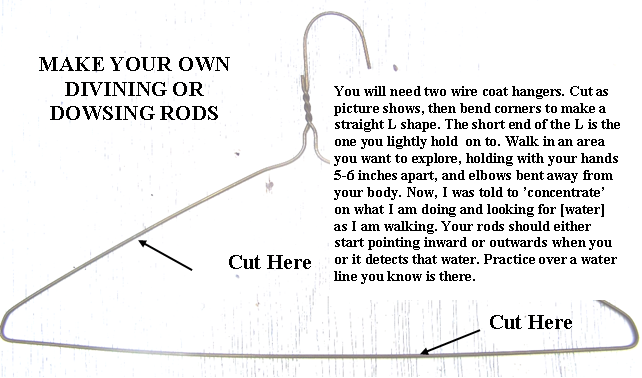 OK,
you don't need an imagination here, what I am going to tell you,
I believe is true. Water Witches are people that can find water,
unscientifically, deep under the ground with a tree branch
shaped like a Y or two wires bent in the shape of an L, made
from a simple wire coat hanger, the ones I have seen. In fact,
there are scientists, engineers, and professors that will argue
until they are blue in the face, that you can't find water
underground by using a Y stick or bent wire like an L. They'll
tell you there is no scientific evidence that anyone can find
water in this way.
OK,
you don't need an imagination here, what I am going to tell you,
I believe is true. Water Witches are people that can find water,
unscientifically, deep under the ground with a tree branch
shaped like a Y or two wires bent in the shape of an L, made
from a simple wire coat hanger, the ones I have seen. In fact,
there are scientists, engineers, and professors that will argue
until they are blue in the face, that you can't find water
underground by using a Y stick or bent wire like an L. They'll
tell you there is no scientific evidence that anyone can find
water in this way.  Wonder
no more, the answer is here. Some will argue they are not a fish but
are “Vertebrates.” If you really want to know what a “Vertebrate”
is, Google it, but, in the meantime lets treat them as a
pre-historic, blood sucking fish that attaches itself to other fish
and proceeds to suck the blood and the life out of fish 10 times
their size. According to the NY Department of Environmental
Conservation, [DEC] “Sea lamprey have two separated fins on their
back (dorsal fins) and suction disk mouth filled with small sharp,
rasping teeth and a file-like tongue.”………. “The sea lamprey is a
jawless parasite that feeds on the body fluids of fish.”
Wonder
no more, the answer is here. Some will argue they are not a fish but
are “Vertebrates.” If you really want to know what a “Vertebrate”
is, Google it, but, in the meantime lets treat them as a
pre-historic, blood sucking fish that attaches itself to other fish
and proceeds to suck the blood and the life out of fish 10 times
their size. According to the NY Department of Environmental
Conservation, [DEC] “Sea lamprey have two separated fins on their
back (dorsal fins) and suction disk mouth filled with small sharp,
rasping teeth and a file-like tongue.”………. “The sea lamprey is a
jawless parasite that feeds on the body fluids of fish.”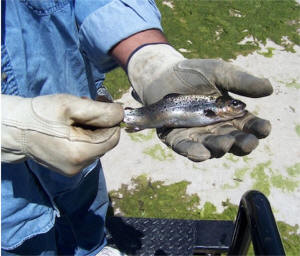
 Whenever
I hear the word "rodent," right away I think of mice and rats, but
in the rodent "family" there are many different sizes and types of
relatives. All rodents have the distinction of having a single pair
of incisors in both the lower and upper jaws, especially made for
gnawing.
Whenever
I hear the word "rodent," right away I think of mice and rats, but
in the rodent "family" there are many different sizes and types of
relatives. All rodents have the distinction of having a single pair
of incisors in both the lower and upper jaws, especially made for
gnawing.  Although
mainly a nocturnal animal, beavers can be spotted occasionally during
the day, and their homes or “lodges” I suppose they can be seen around
the County along different streams and creeks. There is a “lodge” along
the park trail at Four Mile Creek in the State Park; along your walk on
the path, you can see trees that are chomped upon by these little
lumberjacks. I must admit, this summer I haven’t taken my walks along
Four Mile creek, but in prior years I have seen many beaver signs and
the gnawing of trees.
Although
mainly a nocturnal animal, beavers can be spotted occasionally during
the day, and their homes or “lodges” I suppose they can be seen around
the County along different streams and creeks. There is a “lodge” along
the park trail at Four Mile Creek in the State Park; along your walk on
the path, you can see trees that are chomped upon by these little
lumberjacks. I must admit, this summer I haven’t taken my walks along
Four Mile creek, but in prior years I have seen many beaver signs and
the gnawing of trees. Occasionally I bump into a long time friend of mine
and we get into some great conversations, and a few evenings ago was no
different. Bob Rougeaux and I were natives of Niagara Falls, and, now we
both live in the Town of Porter. We both went to Sacred Heart grade
school at the same time, and both had similar after school passions. We
didn’t have anything near what occupies kids today, like all those
sophisticated electronics. We had tube radios, 12 inch B&W televisions,
and yes, TV’s had tubes too, and test patterns that came on at midnight.
Our telephones were the rotary dial kind that kids of today have trouble
trying to operate and big hands and little hands on our watches. Does
anyone know where there is a pay phone on a corner somewhere today?
Friday nights were the big night for TV in my neighborhood with the
Friday Night fights; first, wrestling was on TV from Memorial Auditorium
in Buffalo, with Yukon Eric, Gorgeous George, and a guy named Farmer
Don, who always brought a pig with him into the ring. One guy had a ring
name like, “The Little Flower of Italy,” a bad guy. The next program on
Friday nights was boxing. I can remember some legends like Jersey Joe
Walcott, Sonny Liston and Joe Louis “The Brown Bomber,” because they
were my Father’s favorites, and so was Gillette Blue Blades, Pabst Blue
Ribbon Beer, and the cameo girl “Genny.” Betcha some of you old guys
remember the name “Willie Pep.”
Occasionally I bump into a long time friend of mine
and we get into some great conversations, and a few evenings ago was no
different. Bob Rougeaux and I were natives of Niagara Falls, and, now we
both live in the Town of Porter. We both went to Sacred Heart grade
school at the same time, and both had similar after school passions. We
didn’t have anything near what occupies kids today, like all those
sophisticated electronics. We had tube radios, 12 inch B&W televisions,
and yes, TV’s had tubes too, and test patterns that came on at midnight.
Our telephones were the rotary dial kind that kids of today have trouble
trying to operate and big hands and little hands on our watches. Does
anyone know where there is a pay phone on a corner somewhere today?
Friday nights were the big night for TV in my neighborhood with the
Friday Night fights; first, wrestling was on TV from Memorial Auditorium
in Buffalo, with Yukon Eric, Gorgeous George, and a guy named Farmer
Don, who always brought a pig with him into the ring. One guy had a ring
name like, “The Little Flower of Italy,” a bad guy. The next program on
Friday nights was boxing. I can remember some legends like Jersey Joe
Walcott, Sonny Liston and Joe Louis “The Brown Bomber,” because they
were my Father’s favorites, and so was Gillette Blue Blades, Pabst Blue
Ribbon Beer, and the cameo girl “Genny.” Betcha some of you old guys
remember the name “Willie Pep.” Last Saturday my grandson Jesse, son Danny, and I
went on a little fishing excursion for bass on the Lower Niagara. It was
a bright, no wind, and event filled day as it seemed the fish wanted to
show off. Danny latched onto the first fish, and it was a monster.
Apparently, he was fishing with a dull hook because he got it to the
edge of the boat and the fish winked at him, jiggled his head, spit the
hook, and swam away. He must have told the others to watch out for
plastic motor oil colored tube jigs and to don’t be fooled, stay away
from those things. After that, the little ones that didn’t listen would
come around once in a while and bite one. They were put back in the
water while we waited, for the big boys. Forty minutes later the bigger
guys moved in and we invited some for dinner. Six of them came.
Last Saturday my grandson Jesse, son Danny, and I
went on a little fishing excursion for bass on the Lower Niagara. It was
a bright, no wind, and event filled day as it seemed the fish wanted to
show off. Danny latched onto the first fish, and it was a monster.
Apparently, he was fishing with a dull hook because he got it to the
edge of the boat and the fish winked at him, jiggled his head, spit the
hook, and swam away. He must have told the others to watch out for
plastic motor oil colored tube jigs and to don’t be fooled, stay away
from those things. After that, the little ones that didn’t listen would
come around once in a while and bite one. They were put back in the
water while we waited, for the big boys. Forty minutes later the bigger
guys moved in and we invited some for dinner. Six of them came.  Sometime
ago, I wrote this story about crows. My story routine is, I hand it to
my wife for story content, and to make sure all the T’s are crossed and
the I’s are dotted. When she finished reading it, I said, “well?” she
crinkled her nose, and said she didn’t think the story was interesting
enough. A couple of weeks later I was sitting with a couple of guys
shooting the breeze, and a crow conversation started. I told them about
this story I wrote, and they were all ears when I told them about it.
When I went home, and after thinking about it, I dug the story up out of
my computer, and I thought if these guys thought crows were interesting,
then others should be too. So, here it is:
Sometime
ago, I wrote this story about crows. My story routine is, I hand it to
my wife for story content, and to make sure all the T’s are crossed and
the I’s are dotted. When she finished reading it, I said, “well?” she
crinkled her nose, and said she didn’t think the story was interesting
enough. A couple of weeks later I was sitting with a couple of guys
shooting the breeze, and a crow conversation started. I told them about
this story I wrote, and they were all ears when I told them about it.
When I went home, and after thinking about it, I dug the story up out of
my computer, and I thought if these guys thought crows were interesting,
then others should be too. So, here it is:  I
recently wrote an article for the Sentinel about Coyotes. I met a friend
in Youngstown at Melloni’s Market Place, and he told me he had read the
article, and asked if I heard anything about bobcats in the Niagara
area. That discussion brought me back to a time when I thought I saw one
on the roadway, about 150 yards away looking at me from the road. I
didn’t see the whole animal up close, nor did I recognize it from that
distance, and it looked like an overgrown housecat or a stray field cat,
but as I drove closer it sauntered off into the field at the side of the
road. I kept my eye on that spot, and as I approached the area where it
disappeared, then all of a sudden I could see its hind end and the short
tail, and in about two jumps, it was gone. About a month or so after
that, I was in Bandana’s on Lake Road, and a friend and I got into a
conversation about different things, and he mentioned he spotted what he
thought was a bobcat near his house, but had only gotten a glimpse also.
We both live in the same general area around Bandana’s, and our
description of what we saw were similar, short spotted tail, and
brownish hind quarters. After our sightings, I did some investigating
with area sportsmen/hunters to learn if they ever spotted any creatures
around here that would meet that description, and no one ever even heard
of one around here. Time has passed and I forgot all about my sighting
until my friend in Melloni’s Market asked me about these ‘cats.
I
recently wrote an article for the Sentinel about Coyotes. I met a friend
in Youngstown at Melloni’s Market Place, and he told me he had read the
article, and asked if I heard anything about bobcats in the Niagara
area. That discussion brought me back to a time when I thought I saw one
on the roadway, about 150 yards away looking at me from the road. I
didn’t see the whole animal up close, nor did I recognize it from that
distance, and it looked like an overgrown housecat or a stray field cat,
but as I drove closer it sauntered off into the field at the side of the
road. I kept my eye on that spot, and as I approached the area where it
disappeared, then all of a sudden I could see its hind end and the short
tail, and in about two jumps, it was gone. About a month or so after
that, I was in Bandana’s on Lake Road, and a friend and I got into a
conversation about different things, and he mentioned he spotted what he
thought was a bobcat near his house, but had only gotten a glimpse also.
We both live in the same general area around Bandana’s, and our
description of what we saw were similar, short spotted tail, and
brownish hind quarters. After our sightings, I did some investigating
with area sportsmen/hunters to learn if they ever spotted any creatures
around here that would meet that description, and no one ever even heard
of one around here. Time has passed and I forgot all about my sighting
until my friend in Melloni’s Market asked me about these ‘cats. 
